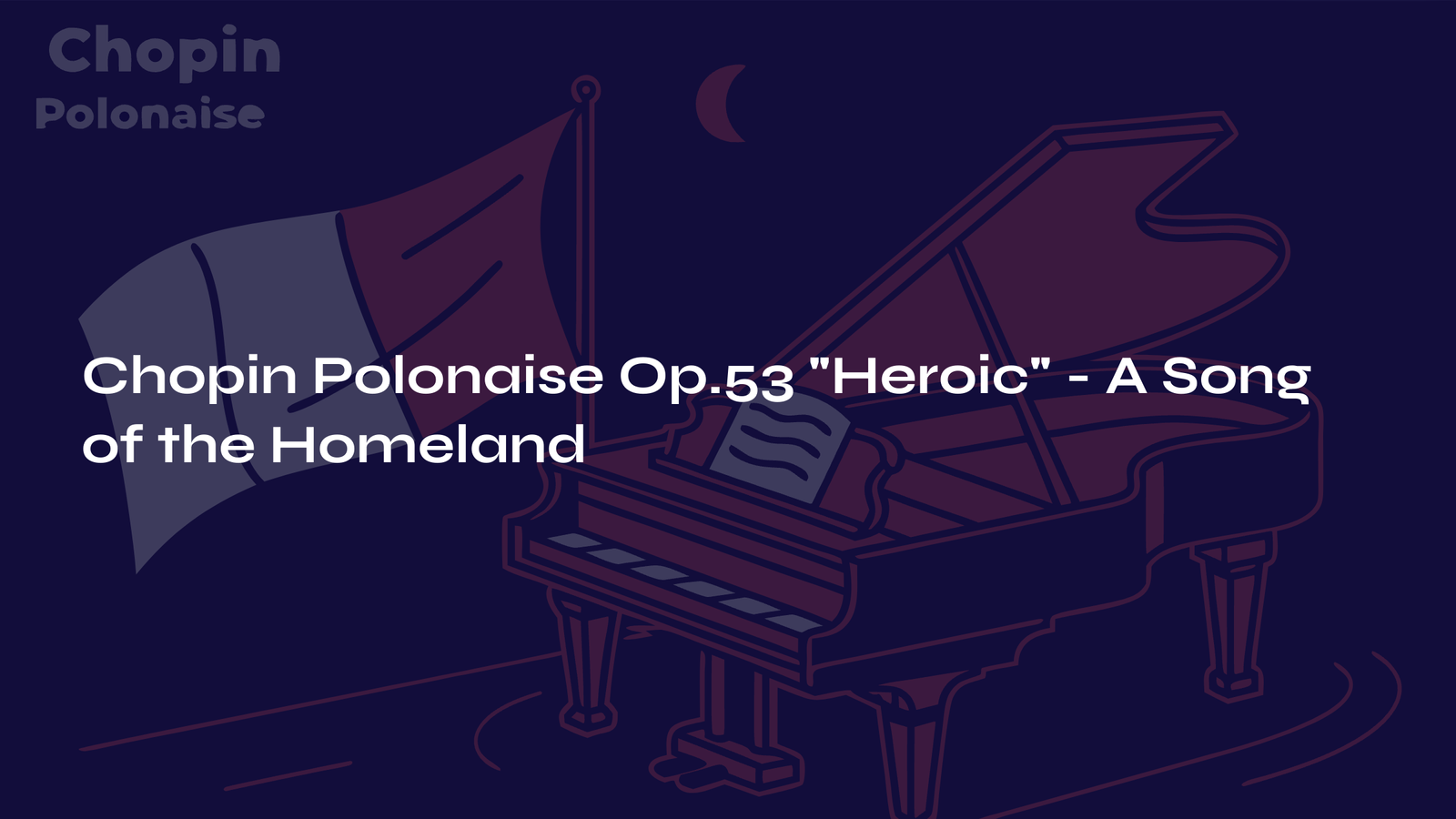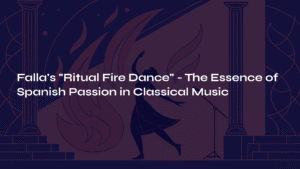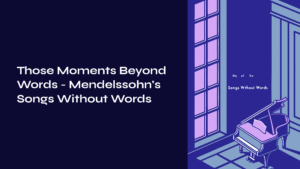Table of Contents
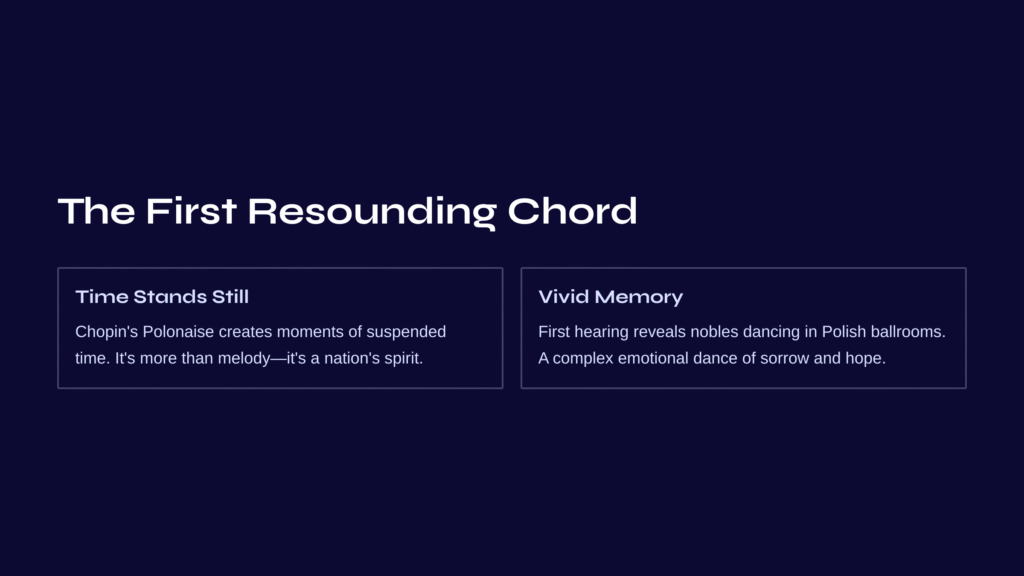
The Thrill of That First Resounding Chord
When you hear the first chord cascading across the piano keys, you experience a moment when time seems to stand still. Chopin’s Polonaise Op.53 “Heroic” is precisely that kind of music. It’s not merely a beautiful melody, but a musical waterfall where the dreams, despair, and indomitable will of an entire nation pour forth across 88 keys.
My memory of first encountering this piece remains vivid to this day. The moment the performer’s fingers struck the keys, it was as if I could see nobles dancing in a distant Polish ballroom unfolding before my eyes. But this was no simple dance. It was a complex yet sublime emotional dance, mixing the sorrow of a lost homeland with the hope of its eventual restoration.

1842: The Polish Soul Born in Paris
The year 1842, when Chopin completed this work, was special for him. More than a decade had passed since he left his homeland Poland, yet his longing for home had only deepened. Considering that the polonaise form itself originated from traditional Polish dance, this piece transcended being merely a piano work—it was a composer’s declaration of identity.
Romantic era composers of the time showed great interest in expressing national identity through music. Chopin was no exception. Op.53 in particular stands as the most grandiose and dramatic of his polonaises, earning the nickname “Heroic” when George Sand praised its “inspiration, force, and vigor,” calling it a “heroic symbol.”
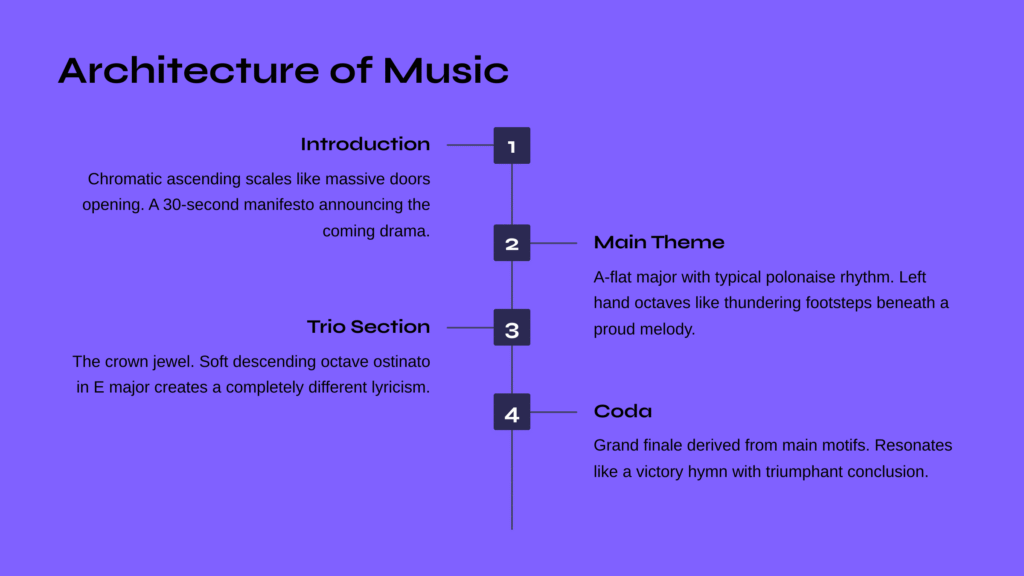
The Architecture of Music – A Grand Epic Created by Each Section
Introduction: Fanfare Announcing the Hero’s Arrival
From the very opening, Chopin overwhelms us. The chromatic ascending scales played by both hands sound like massive doors opening. This approximately 30-second introduction isn’t merely an opening passage—it’s a manifesto announcing the scale of the drama about to unfold.
Watching the performer’s fingers race across the keys evokes the tension of atmospheric changes before a storm. Every time I hear this section, I imagine a protagonist making their entrance on stage.
Main Theme: The Majestic March Painted by Polonaise Rhythm
The main theme beginning in A-flat major follows the typical polonaise rhythm. This rhythm, with strong accents on the first beat of 3/4 time, appears simple but transforms into an entirely different dimension of music through Chopin’s hands.
The octaves played by the left hand sound like footsteps thundering across the earth. Above them, the melody drawn by the right hand is sometimes proud, sometimes poignant. The effect created by this contrast is truly remarkable. When the same theme repeats an octave higher, decorated with trills, it creates a sparkling sonority like light reflecting off jewels.
First Interlude: A Moment of Paused Reflection
The first interlude, consisting of 16 measures, is relatively brief but plays a crucial role in connecting the main theme to the next section. As harmonic progressions unfold calmly, it feels as if the hero has momentarily stopped to gaze into the distance.
Trio: Journey to a New World
The second interlude spanning 74 measures—the trio section—can be called the crown jewel of this piece. Beginning with six fortissimo arpeggio chords, this section feels like the curtain rising on a new scene.
The soft descending octave ostinato beginning in E major is truly impressive. Above this repetitive pattern created by the left hand, a march-like melody appears twice, displaying a lyricism completely different from the earlier grandeur. It’s like the heart of a soldier longing for home from the battlefield.
As this section modulates to E-flat major, revealing deeper emotional layers, then returns to A-flat major through a lyrical transitional passage, the process feels wonderfully natural and beautiful.
Recapitulation and Coda: The Hero’s Return and Victory
When the theme returns, it becomes far more dramatic than initially. Chopin doesn’t simply repeat—he overwhelms us once again with amplified drama. The grand coda derived from the main motifs resonates like a victory hymn, bringing the piece to a triumphant conclusion.
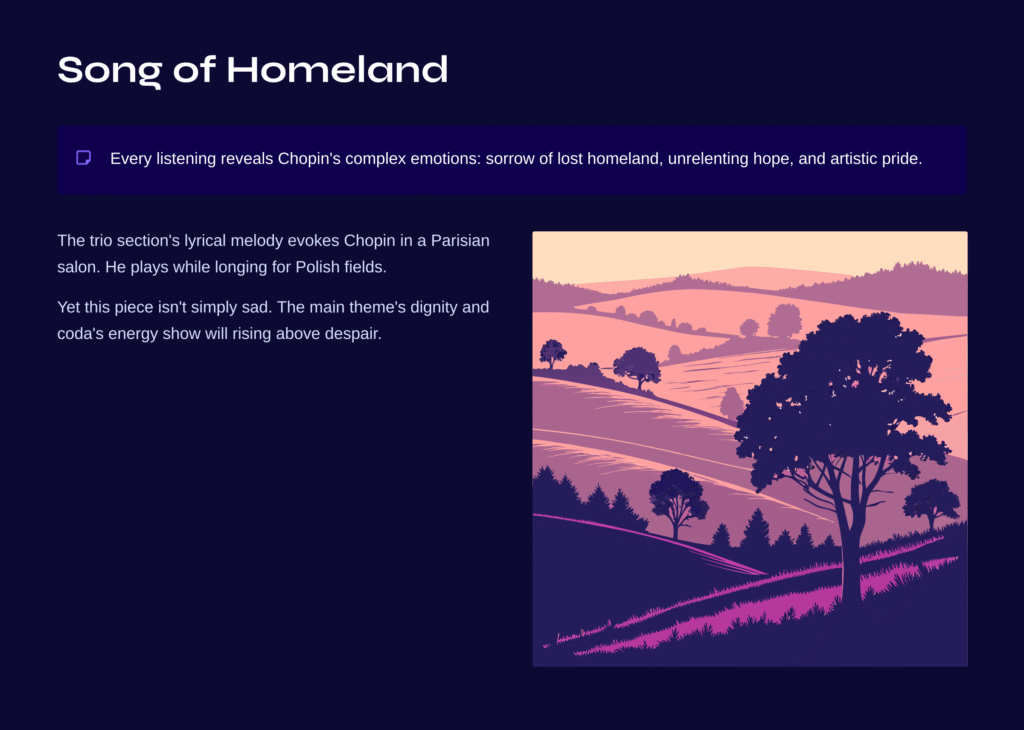
The Song of Homeland Resonating in My Heart
Every time I listen to this piece, I find myself sharing Chopin’s complex emotions. The sorrow of losing one’s homeland, yet an unrelenting hope, and the pride of an artist—all these feelings intertwined.
Particularly when I hear the lyrical melody of the trio section, I can almost see Chopin in a Parisian salon, playing while longing for the fields of his Polish homeland. That deep nostalgia and poignancy, expressible only through the language of music, penetrates deep into my soul.
Yet this piece isn’t simply sad. The dignity felt in the main theme and the energy exploding in the coda demonstrate the power of will rising above despair. Perhaps this is why this piece came to bear the name “Heroic.”
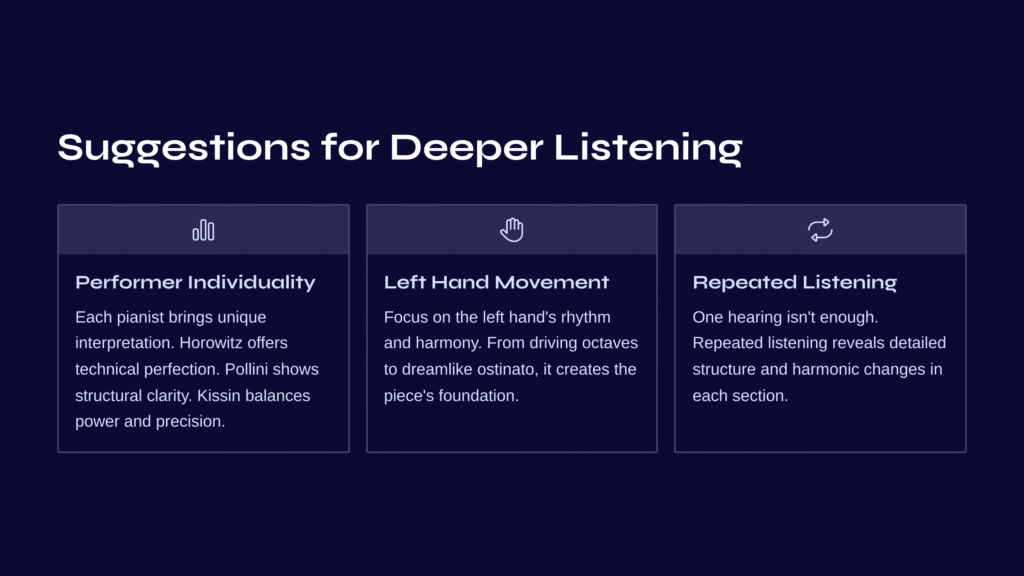
Small Suggestions for Deeper Listening
Pay Attention to Each Performer’s Individuality
This piece gives completely different impressions depending on the performer. Vladimir Horowitz’s 1971 performance shines with technical perfection and dramatic interpretation, while Maurizio Pollini’s interpretation shows a more structural and clear approach. Evgeny Kissin’s performance offers a perfect harmony of power and clarity.
The fact that the same score can create such different music—isn’t that the very charm of classical music?
Follow the Left Hand’s Movement
When listening to this piece, particularly focus on the rhythm and harmony created by the left hand. From the driving force created by the continuously repeated octaves in the main theme to the dreamlike atmosphere created by the gentle ostinato in the trio, you’ll feel how crucial the left hand’s role truly is.
The Value of Repeated Listening
This piece doesn’t reveal its full worth in a single listening. Initially, you’ll be overwhelmed by the overall flow and grandeur, but repeated listening brings the joy of discovering the detailed structure and harmonic changes of each section. Exploring the tonal changes in the trio section and the variation techniques of the themes also makes for excellent listening practice.
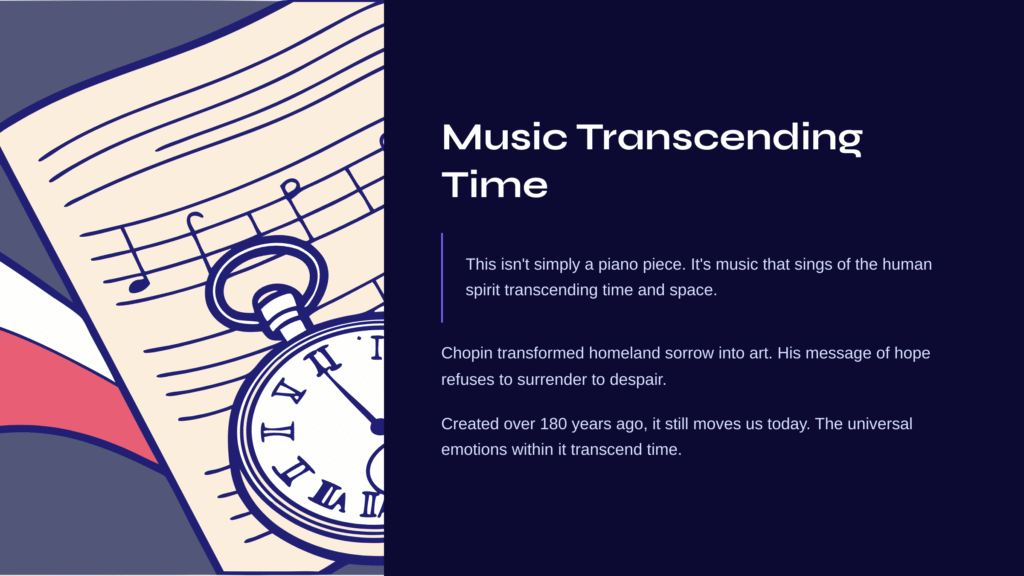
The Power of Music Transcending Time
Chopin’s Polonaise Op.53 “Heroic” isn’t simply a piano piece written by a 19th-century Polish composer. This is music that sings of the triumph of the human spirit transcending time and space.
Chopin’s will to sublimate the sorrow of losing his homeland into art, the message of hope that refuses to surrender before desperate reality, and above all, the depth and complexity of human emotion expressible only through the language of music—all of this is contained within these 6 minutes and 30 seconds.
Every time I listen to this piece, I reflect: true art transcends its era. The reason this music, created over 180 years ago in Paris while longing for homeland, still moves us today is because the universal human emotions and will contained within it transcend time.

Next Destination: Brahms Hungarian Dance No. 1
If the afterglow of emotion felt from Chopin’s heroic epic still lingers, how about exploring another nation’s musical identity? Brahms’s Hungarian Dance No. 1 is a work that reveals ethnic color in yet another way from Chopin’s polonaise.
Brahms directly collected and studied Hungarian folk songs to create these dances. While Chopin inherited the aristocratic dance tradition of Poland, Brahms captured the energy of more populist and primitive Hungarian folk music. Particularly No. 1 is music filled from beginning to end with dynamic rhythms and exotic melodies, like watching the passionate dance of Romani people.
Originally composed for four hands but also famous in its orchestral version, this work shows extroverted, festive energy in contrast to Chopin’s introspective and lyrical patriotism. Comparing how these two composers expressed different national souls through music would be truly fascinating.
